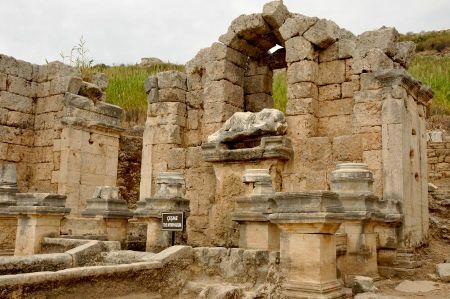Perge - History of a city - founded by colonists
- Written by Portal Editor
Perge - According to the Greek Writer Strabon (63 BC-19 AD) the city was founded by Greek colonists led by Mopsos and Kalchas who came to Pamphylia after the Trojan War around 1200 BC.
These two gentlemen are responsible for many towns, so we have to take Strabo’s information with a grain of salt, but in Perge’s case it may be true as bases of statues from c 120 AD have been found by the Hellenistic gate with names of 7 heroes from the Trojan War on them: Mopsos, Kalchas, Riksos, Labos, Machaon, Leonteus and Minyasas. But as for the other towns in the area it is likely that there was a Hittite settlement on the town hill before that. The name Perge is Luvian (Parga), meaning hill. The Hittites’ Luvian language was spoken in South Anatolia already from the 3rd millennium BC.
Seven heroes of the Trojan War: Mopsus, Calchas, Rixus, Labus, Machaon, Leonteus and Minyasas
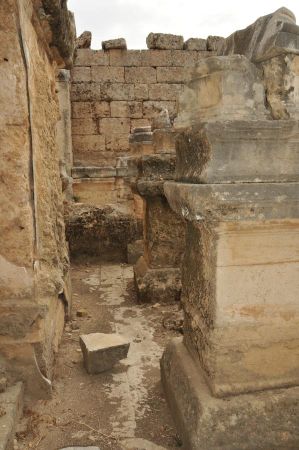 Perge is situated in a fertile area on a hill easy to defend and in rather safe distance from the sea. The nearby river Kestros then had access to the sea and the important trade. As for the rest of Pamphylia Perge was under Persian rule until Alexander’s arrival in 333 BC. The town surrendered willingly, maybe because the defensive walls were weak. They even provided Alexander with guides to take him and his army through the impassable Taurus Mountains so he could quickly get to Aspendos and Side, with whom Perge had bad relations.
Perge is situated in a fertile area on a hill easy to defend and in rather safe distance from the sea. The nearby river Kestros then had access to the sea and the important trade. As for the rest of Pamphylia Perge was under Persian rule until Alexander’s arrival in 333 BC. The town surrendered willingly, maybe because the defensive walls were weak. They even provided Alexander with guides to take him and his army through the impassable Taurus Mountains so he could quickly get to Aspendos and Side, with whom Perge had bad relations.
After Alexander’s death and the infighting between his generals the town came under the Seleucid Dynasty in Syria, also founded by one of Alexander’s generals, in 301 BC. A strong wall was built in the 3rd and 2nd centuries BC. The town experienced its first revival under Seleucid rule. It was then that the mathematician and astronomer Appolonius (ca 262-190 BC) grew up in the town. He was later educated at Alexandria in Egypt and was especially interested in ellipses and parabolas and other things related to geometry and tracks of planets. His theory of the tracks of planets was rediscovered in the Renaissance when both Tyge Brahe and Kepler developed it further. Together with his contemporary Archimedes he defined the figure π (pi).
Perge did not have the best relationship with Aspendos and Side
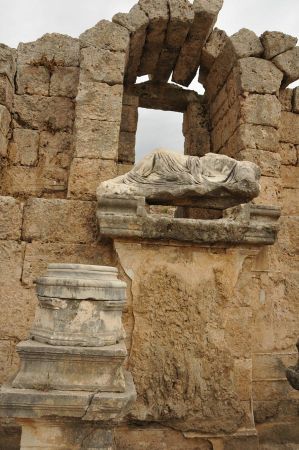 In the meantime a new empire had appeared in West Anatolia, Pergamon. After the war in 192-188 BC between the Seleucids and Pergamon, which was supported by Rome, the Seleucids had to hand over Pamphylia to Pergamon.
In the meantime a new empire had appeared in West Anatolia, Pergamon. After the war in 192-188 BC between the Seleucids and Pergamon, which was supported by Rome, the Seleucids had to hand over Pamphylia to Pergamon.
But Perge put up a fight. In 188 BC the Romans sent a consul to Perge. When he discovered that the Seleucids had a garrison in the town he besieged it until Perge surrendered.
Pergamon had to wage 2 wars in 165 and 159-158 BC to retake the town. In 133 the last king in Perga-mon died, and before that he had willed his kingdom to the Romans. So Perge became a part of the Roman Empire.
 But the next 100 years were rather turbulent with attacks from Cilician pirates, uprisings against the Romans and Roman civil wars. Fleecing and imposition of taxes took the shine off Perge until the Pax Romana descended on the town.
But the next 100 years were rather turbulent with attacks from Cilician pirates, uprisings against the Romans and Roman civil wars. Fleecing and imposition of taxes took the shine off Perge until the Pax Romana descended on the town.
But peace time was no guarantee against fleecing. It was common practice that Roman governors used their office to aquire as much wealth as possible, before they returned to Rome after 1-2 years or were given a new office. But some were worse than others.
One of the bad ones was Gaius Verres, who was later sentenced in Rome for his extortion of Sicilia and Cilicia. He was a great art collector and in 79 BC he robbed the town’s Artemis temple, including the gold on the goddess’s statue. The same year he went thieving in Aspendos. 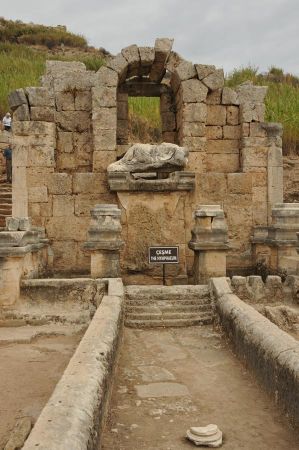 The goddess Artemis, daughter of Zeus and sister of Apollo, was the town’s patron, appearing in many places. From the 3rd century she thrones as a statue or hunter on Hellenistic coins under the Pamphylian name Vanessa Preiia (Queen of Perge) and later under her Greek name Artemis Pergaia, and several statues and reliefs depict her. She was also goddess of fertility and protector of wild animals, children, women and the frail, and originally she was an old Anatolian mother goddess “Hellenized” by the Greek immigrants.
The goddess Artemis, daughter of Zeus and sister of Apollo, was the town’s patron, appearing in many places. From the 3rd century she thrones as a statue or hunter on Hellenistic coins under the Pamphylian name Vanessa Preiia (Queen of Perge) and later under her Greek name Artemis Pergaia, and several statues and reliefs depict her. She was also goddess of fertility and protector of wild animals, children, women and the frail, and originally she was an old Anatolian mother goddess “Hellenized” by the Greek immigrants.
Her temple, which according to Strabo (63 BC-19 AD) was on a hill outside town, is reported to have been big and beautiful and the statue inside covered in gold. The temple was a shrine, but it has not been found. On a hill south east of the town a list was found with temple inventory and a cultic Artemis bust surrounded by the 12 signs in the zodiac, but no temple. Also the hill Koca Belen above the theatre has been searched, but no temple was found. Probably it was removed completely when Christianity became the state religion, or a church has been built on top.
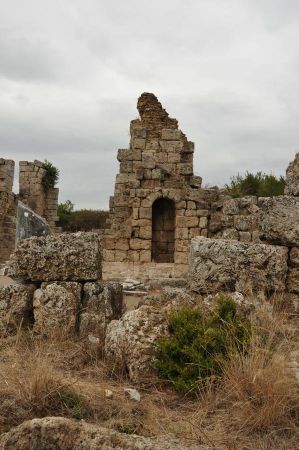 Under the Roman rule the town experienced its glory. From the 1st to the 3rd century the town grew and much building went on. Everything went according to a town development plan that even today is impressive. The fortifications were improved and it became one of the most beautiful towns not just in Pamphy-lia but in the whole of Anatolia.
Under the Roman rule the town experienced its glory. From the 1st to the 3rd century the town grew and much building went on. Everything went according to a town development plan that even today is impressive. The fortifications were improved and it became one of the most beautiful towns not just in Pamphy-lia but in the whole of Anatolia.
At the beginning of the 2nd century the rich Plancia Magna was the greatest donor and initiator of public building. She was the daughter of the governor Plancius Varus, and the greatful citizens and the town council honoured her with the highest title of honour and with statues. She was also a priestess at the Artemis Temple and high priestess at the imperial cult. In the 3rd century Perge and Side competed about the status of most important town in Pamphylia, and both town wrote on their coins: “First in Pamphylia”.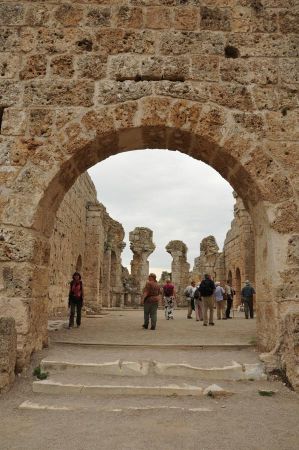 Perge was one of the first places where Christian missionary work took place. Paul the Apostle visited the town twice around 50 AD. The strongest opponents of Christianity were the Artemis worshippers until the statues were robbed and the function was stopped under Emperor Diocletian (284-305). There are indications that the Christians for a long time identified Artemis with Virgin Mary and Apollo with Jesus. The town became a Christian centre under Constantine the Great (324-337). From East Roman time*, when Perge became a bishop’s residence, 3 basilica churches testify to the victory of Christianity. But in Byzan-tine time* the decline set in, the river sanded up and the Arab pirates attacks in the 7th century tolled the knell of Perge. The inhabitants moved out, many to Antalya, and the town died out. Earthquakes laid the town in ruins and flooding put a protective layer of earth over the rest.
Perge was one of the first places where Christian missionary work took place. Paul the Apostle visited the town twice around 50 AD. The strongest opponents of Christianity were the Artemis worshippers until the statues were robbed and the function was stopped under Emperor Diocletian (284-305). There are indications that the Christians for a long time identified Artemis with Virgin Mary and Apollo with Jesus. The town became a Christian centre under Constantine the Great (324-337). From East Roman time*, when Perge became a bishop’s residence, 3 basilica churches testify to the victory of Christianity. But in Byzan-tine time* the decline set in, the river sanded up and the Arab pirates attacks in the 7th century tolled the knell of Perge. The inhabitants moved out, many to Antalya, and the town died out. Earthquakes laid the town in ruins and flooding put a protective layer of earth over the rest.
In the beginning of the 20th century the locals started using the ruins as building materials. Since 1946 the town has been under excavation by Turkish archaeologists, and many finds are at the Antalya Museum.
Perge – The Fascinating History of an Ancient Metropolis on the Turkish Riviera
Introduction: Perge – Where Antiquity Comes to Life
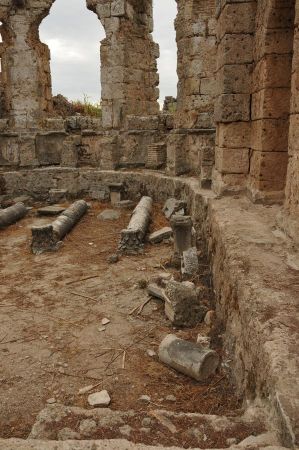 The Turkish Riviera is rich in history, but few places bring it to life as much as Perge. Located approximately 18 kilometres east of Antalya, the ancient city is one of Turkey's most important archaeological sites. Temples, colonnaded streets, baths, and a mighty stadium testify to the former greatness of this metropolis. But Perge was more than just a city – it was a hub of religion, trade, and culture that continues to captivate visitors today.
The Turkish Riviera is rich in history, but few places bring it to life as much as Perge. Located approximately 18 kilometres east of Antalya, the ancient city is one of Turkey's most important archaeological sites. Temples, colonnaded streets, baths, and a mighty stadium testify to the former greatness of this metropolis. But Perge was more than just a city – it was a hub of religion, trade, and culture that continues to captivate visitors today.
The Beginnings – Greek Roots in Asia Minor
According to ancient sources, Perge was founded as early as the 12th century BC, probably by Greek settlers from Arcadia. The city quickly developed into a centre of science, art, and trade. Its location away from the coast, yet close to the Kestros River (now Aksu), made it a safe but easily accessible place.
Perge in the Hellenistic Period
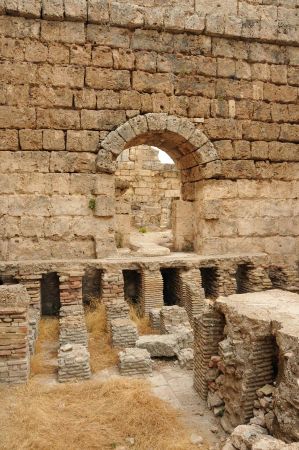 During the Hellenistic period – after the death of Alexander the Great – Perge became a prosperous city. The geometrically planned city layout, the wide colonnaded street with its water channel, the theatre, and the agora largely date from this period. The city boasted a sophisticated sewage system and a well-thought-out cityscape – a masterpiece of ancient urban planning.
During the Hellenistic period – after the death of Alexander the Great – Perge became a prosperous city. The geometrically planned city layout, the wide colonnaded street with its water channel, the theatre, and the agora largely date from this period. The city boasted a sophisticated sewage system and a well-thought-out cityscape – a masterpiece of ancient urban planning.
The Golden Age under the Romans
Perge reached its greatest splendour under Roman rule in the 2nd century AD. Many of the buildings visible today were built during this period:
- The Roman stadium (seating 12,000 spectators)
• The thermal baths with hypocaust heating
• Monumental city gates with towers
• The nymphaeums and fountain houses
• The agora with the Temple of Hermes
Perge was rich, important – and above all, magnificent. The combination of Hellenistic elegance and Roman monumentality defines the charm of this city.
The Cult of Artemis of Perge
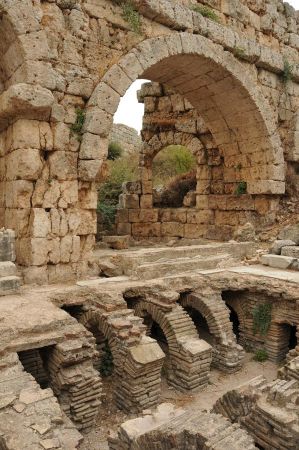 Perge was particularly famous for the cult of Artemis Pergaia, a local goddess who merged with the Greek Artemis and the Anatolian Cybele. An imposing Temple of Artemis once stood outside the city walls. The priestesses exerted great influence on social life—an indication of Perge's spiritual significance.
Perge was particularly famous for the cult of Artemis Pergaia, a local goddess who merged with the Greek Artemis and the Anatolian Cybele. An imposing Temple of Artemis once stood outside the city walls. The priestesses exerted great influence on social life—an indication of Perge's spiritual significance.
The Role of Paul of Tarsus
Early Christianity also played a role in the city's history. The Apostle Paul visited Perge on his first missionary journey (Acts 13). This later made the city a bishopric in Byzantine times. Even today, the so-called Paul Street commemorates his route through the city.
Impressive Buildings – Must-Sees
1. The Roman Theatre
 With a capacity of around 15,000 seats, the theatre of Perge is one of the largest in the region. The stage wall (scaenae frons) is richly decorated with mythological reliefs. Particularly well-preserved: the orchestra pit and the entrance arch.
With a capacity of around 15,000 seats, the theatre of Perge is one of the largest in the region. The stage wall (scaenae frons) is richly decorated with mythological reliefs. Particularly well-preserved: the orchestra pit and the entrance arch.
2. The Stadium
It is one of the best-preserved ancient stadiums in the world. With 17 rows of seats and 70 arches, it was a venue for athletic competitions and perhaps also gladiatorial fights.
3. The Colonnaded Street
This magnificent street runs directly through the city, flanked by Ionic and Corinthian columns. A water channel in the centre not only provided supplies but also produced the characteristic sound of the water flowing – an ancient sound design.
4. The Hellenistic Towers
 The two imposing towers of the Hellenistic city gate are unique in Anatolia. They impressively demonstrate the transition from Greek to Roman architecture.
The two imposing towers of the Hellenistic city gate are unique in Anatolia. They impressively demonstrate the transition from Greek to Roman architecture.
5. The South Gate and the Agora
Here lie the remains of the public buildings, the marketplace, and temple complexes. The agora, with its central temple dedicated to the god Hermes – the patron saint of merchants – is particularly impressive.
Archaeology in Perge – Discoveries in Detail
Excavations have been intensive in Perge since the 20th century. The discovery of mosaics, statues, and inscriptions in particular has contributed significantly to the reconstruction of the city's history. Many of these pieces are now on display in the Antalya Archaeological Museum, including:
- Statues of Nemesis, Asclepius, and Heracles
• Busts of Roman emperors
• Everyday objects such as oil lamps, amphorae, and jewelry
Perge Today – A First-Class Open-Air Museum
 Today, Perge is one of the most accessible ancient sites in Turkey. Thanks to modern infrastructure, signage, and guided tours, you can experience history up close. The atmosphere is quiet and rarely crowded – perfect for explorers, photographers, and culture vultures.
Today, Perge is one of the most accessible ancient sites in Turkey. Thanks to modern infrastructure, signage, and guided tours, you can experience history up close. The atmosphere is quiet and rarely crowded – perfect for explorers, photographers, and culture vultures.
Tips for your visit to Perge
- Getting there: From Antalya city center, about 30 minutes by car or bus towards Aksu
• Opening hours: Daily from 8:00 a.m. to 7:00 p.m. (shorter in winter)
• Admission: Approx. 100–150 TL, combined ticket with Aspendos and Side available
• Duration: Allow at least 2–3 hours
• Equipment: Sunscreen, sturdy shoes, camera, water
Why Perge is unique
 Perge is more than just a ruin. It is an open history in stone where you can experience ancient life. The combination of architectural sophistication, religious influence, and cultural diversity makes Perge a historical gem that has retained its dignity and fascination to this day.
Perge is more than just a ruin. It is an open history in stone where you can experience ancient life. The combination of architectural sophistication, religious influence, and cultural diversity makes Perge a historical gem that has retained its dignity and fascination to this day.
Conclusion – Perge is a window into the ancient world
Anyone interested in ancient Rome, Greek mythology, or early Christianity cannot miss Perge. Here, you can walk through streets once walked by Roman senators, priestesses of Artemis, or Paul of Tarsus. It is a place that inspires, moves, and makes visitors feel like they are part of history.
FAQs about Perge
 1. Can you walk freely in Perge?
1. Can you walk freely in Perge?
Yes, the area is extensive and largely open to the public. Please respect the paths.
2. Is there a shop or snack bar on-site?
At the entrance, you'll find small stands selling water, snacks, and souvenirs.
3. Is Perge wheelchair accessible?
Partially – many paths are uneven, so wheelchair users should be accompanied.
4. What other attractions are nearby?
Aspendos, Side, Termessos, and the Antalya Archaeological Museum.
5. Are there guided tours available in German?
Yes, many tour operators in Antalya also offer German-speaking guides
Please read as well:
The ancient town of Perge next to Antalya
Patara Beach - relaxing after visiting the Patara ruins
-
 Perge - History of the ancient City
Perge - History of the ancient City
Perge - History of the ancient City
Perge - History of the ancient City
-
 Perge - History of the ancient City
Perge - History of the ancient City
Perge - History of the ancient City
Perge - History of the ancient City
-
 Perge - History of the ancient City
Perge - History of the ancient City
Perge - History of the ancient City
Perge - History of the ancient City
-
 Perge - History of the ancient City
Perge - History of the ancient City
Perge - History of the ancient City
Perge - History of the ancient City
-
 Perge - History of the ancient City
Perge - History of the ancient City
Perge - History of the ancient City
Perge - History of the ancient City
-
 Perge - History of the ancient City
Perge - History of the ancient City
Perge - History of the ancient City
Perge - History of the ancient City
-
 Perge - History of the ancient City
Perge - History of the ancient City
Perge - History of the ancient City
Perge - History of the ancient City
-
 Perge - History of the ancient City
Perge - History of the ancient City
Perge - History of the ancient City
Perge - History of the ancient City
-
 Perge - History of the ancient City
Perge - History of the ancient City
Perge - History of the ancient City
Perge - History of the ancient City
-
 Perge - History of the ancient City
Perge - History of the ancient City
Perge - History of the ancient City
Perge - History of the ancient City
-
 Perge - History of the ancient City
Perge - History of the ancient City
Perge - History of the ancient City
Perge - History of the ancient City
-
 Perge - History of the ancient City
Perge - History of the ancient City
Perge - History of the ancient City
Perge - History of the ancient City
https://www.alaturka.info/en/turkey-country/riviera/2189-history-of-perge#sigProIdc8332a3884
